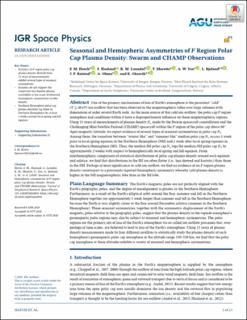| dc.description.abstract | One of the primary mechanisms of loss of Earth's atmosphere is the persistent “cold” ( urn:x-wiley:jgra:media:jgra56068:jgra56068-math-0001 20 eV) ion outflow that has been observed in the magnetospheric lobes over large volumes with dimensions of order several Earth radii. As the main source of this cold ion outflow, the polar cap F region ionosphere and conditions within it have a disproportionate influence on these magnetospheric regions. Using 15 years of measurements of plasma density Ne made by the Swarm spacecraft constellation and the Challenging Mini Satellite Payload (CHAMP) spacecraft within the F region of the polar cap above 80° Apex magnetic latitude, we report evidence of several types of seasonal asymmetries in polar cap Ne. Among these, the transition between “winter‐like” and “summer‐like” median polar cap Ne occurs 1 week prior to local spring equinox in the Northern Hemisphere (NH) and 1 week after local spring equinox in the Southern Hemisphere (SH). Thus, the median SH polar cap Ne lags the median NH polar cap Ne by approximately 2 weeks with respect to hemispherically local spring and fall equinox. From interhemispheric comparison of statistical distributions of polar cap plasma density around each equinox and solstice, we find that distributions in the SH are often flatter (i.e., less skewed and kurtotic) than those in the NH. Perhaps of most significance to cold ion outflow, we find no evidence of an F region plasma density counterpart to a previously reported hemispheric asymmetry whereby cold plasma density is higher in the NH magnetospheric lobe than in the SH lobe.
Plain Language Summary
The Earth's magnetic poles are not perfectly aligned with the Earth's geographic poles, and the degree of misalignment is greater in the Southern Hemisphere. Furthermore, as a result of the Earth's elliptical orbit around the Sun, summer and fall in the Northern Hemisphere together are approximately 1 week longer than summer and fall in the Southern Hemisphere, because the Earth is very slightly closer to the Sun around December solstice (summer in the Southern Hemisphere). These seasonal asymmetries, together with the asymmetric displacement of the Earth's magnetic poles relative to the geographic poles, suggest that the plasma density in the topside ionosphere's geomagnetic polar regions may also be subject to seasonal and hemispheric asymmetries. The polar regions are the primary site of loss of the Earth's atmosphere via so‐called ion outflow processes that, over geological time scales, are believed to lead to loss of the Earth's atmosphere. Using 15 years of plasma density measurements made by four different satellites to statistically study the plasma density of each hemisphere's geomagnetic polar cap ionosphere in the altitude range 350–520 km, we find that the polar cap ionosphere at these altitudes exhibits a variety of seasonal and hemispheric asymmetries. | en_US |

